|
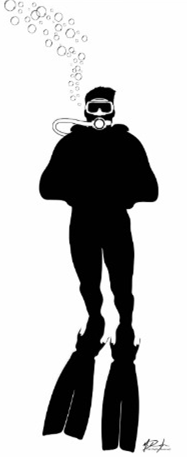

Dive Log
Back to

Back to

|
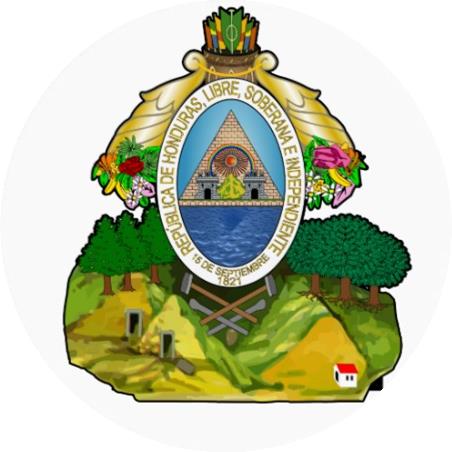
Roatan, Honduras
August, 1983
An unintentional aspect of our selection
process for potential dive resorts is the fact that they
sometimes were in areas on or near war zones. A fact that
my Mother found disturbing. But few Central America
countries can boast of complete tranquility and often what we
read in the press is greatly exaggerated. Our reasoning
for choosing these islands was, let's get in and out before we
can't get in at all. Probably not the most sound of
reasoning.
In August 1983 we began the first of what
was to be two trips to Honduras. Our selection of a dive
operation was more logical than the previous poke-and-pray
method. Anthony's Key Resort on Roatan had a dive
operation managed by Peter Hughes. Having been impressed
with his operation on Bonaire, we figured we could not go wrong
- and we didn't.
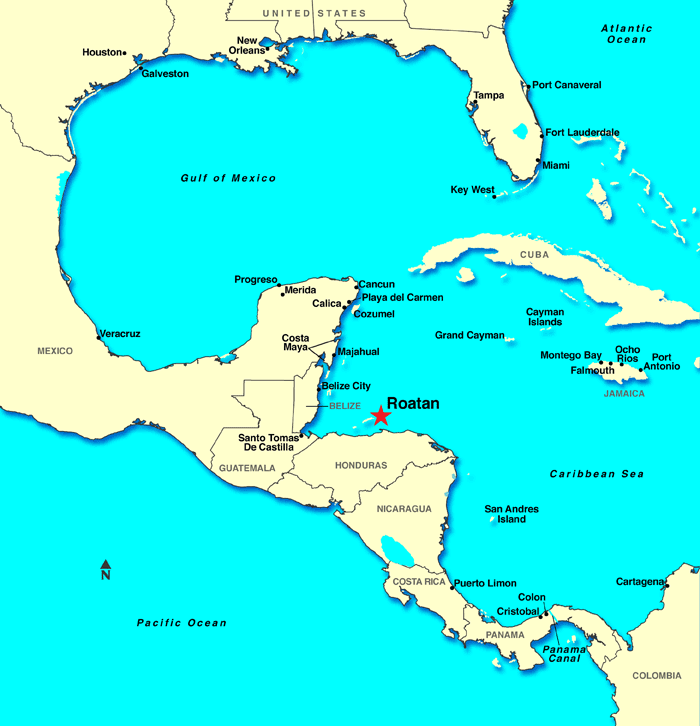
|
A bit of history...
Roatán, located
between the islands of Útila and Guanaja, is the largest
of Honduras' Bay Islands. The island was formerly known
as Ruatan and Rattan. Located near the Mesoamerican
Barrier Reef, the largest barrier reef in the Caribbean
Sea (second largest worldwide after Australia's Great
Barrier Reef), Roatán has become an important cruise
ship and scuba diving destination in Honduras. Tourism
is its most important economic sector, though fishing is
also an important source of income for islanders.
The pre-Columbian
indigenous peoples of the Bay Islands are believed to have been
related to either the Paya, the Maya, the Lenca or the Jicaque,
which were the cultures present on the mainland. Christopher
Columbus on his fourth voyage (1502–1504) came to the islands as
he visited the neighboring Bay Island of Guanaja. Soon after the
Spanish began raiding the islands for slave labor. More
devastating for Native American communities was exposure to
Eurasian infectious diseases to which they had no immunity, such
as smallpox and measles. No indigenous people survived the
consequent epidemics.
Throughout European
colonial times, the Bay of Honduras attracted an array of
individual settlers, pirates, traders and military forces.
Various economic activities were engaged in and political
struggles played out between the European powers, chiefly
Britain and Spain. Roatán and the other islands were used as
frequent resting points for sea travelers. On several occasions,
they were subject to military occupation. In contesting with the
Spanish for colonization of the Caribbean, the English occupied
the Bay Islands on and off between 1550 and 1700. During this
time, buccaneers found the vacated, mostly unprotected islands a
haven for safe harbor and transport. English, French and Dutch
pirates established settlements on the islands. They frequently
raided Spanish cargo vessels carrying gold and other treasures
from the New World to Spain.
In 1797, the British
defeated the Black Carib, who had been supported by the French,
in a battle for control of the Windward Caribbean island of St.
Vincent. Weary of their resistance to British plans for sugar
plantations, the British rounded up the St. Vincent Black Carib
and deported them to Roatán. The majority of Black Carib
migrated to Trujillo on mainland Honduras, but a portion
remained to found the community of Punta Gorda on the
northern coast of Roatán. The Black Carib, whose ancestry
includes Arawak and African Maroons, remained in Punta Gorda,
becoming the Bay Island's first permanent post-Columbian
settlers. They also migrated from there to parts of the northern
coast of Central America, becoming the foundation of the
modern-day Garífuna culture.
The majority permanent
population of Roatán originated from the Cayman Islands near
Jamaica. They arrived in the 1830s shortly after Britain's
abolition of slavery in 1838. The changes in labor force
disrupted the economic structure of Caymanian culture.
Caymanians were largely a seafaring culture and were familiar
with the area from turtle fishing and other activities. Former
Caymanian slaveholders were among the first to settle in the
seaside locations throughout primarily western Roatán. Former
slaves also migrated from the Cayman Islands in larger number
than planters, during the late 1830s and 1840s. Altogether, the
former Caymanians became the largest cultural group on the
island.
For a brief period in
the 1850s, Britain declared the Bay Islands its colony. Within a
decade, the Crown ceded the territory formally back to Honduras.
British colonists were sent though, and asked William Walker, a
freebooter with a private army, to help end the crisis in 1860
by invading Honduras; he was captured upon landing in Trujillo
and executed there.
In the latter half of
the 19th century, the island populations grew steadily and
established new settlements all over Roatán and the other
islands. Settlers came from all over the world and played a part
in shaping the cultural face of the island. Islanders started a
fruit trade industry which became profitable. By the 1870s it
was purchased by American interests, most notably the New
Orleans and Bay Islands Fruit Company. Later companies, the
Standard Fruit and United Fruit Companies became the foundation
for modern-day fruit companies, the industry which gave Honduras
the sobriquet "banana republic".
The 20th century saw
continued population growth resulting in increasing economic
changes, and environmental challenges. A population boom began
with an influx of Spanish-speaking Mestizo migrants from the
Honduran mainland and in the last decades, they tripled the
original resident population. Mestizo migrants settled primarily
in the urban areas of Coxen Hole and Barrio Los Fuertes (near
French Harbor). But in terms of population and economic
influence, the mainlander influx was dwarfed by the overwhelming
tourist presence in most recent years. Numerous American,
Canadian, British, New Zealand, Australian and South African
settlers and entrepreneurs engaged chiefly in the fishing
industry, and later, provided the foundation for attracting the
tourist trade. |
The trip occurred during a time of
military unrest that was evident when we flew into the airport
at San Pedro. The United States - having been sent to
assist in quieting the trouble - had established a temporary
base along side the Honduran military post. We arrived
just in time to see a Globe Master land and unload its cargo.
How those flying warehouses get off the ground and stay in the
air is beyond my comprehension.
Customs at San Pedro was very
militaristic; with armed guards standing at each check point.
All I could think of at the time as, "if we get in trouble, how
fast could we run to the U.S. side?" Not being able to
speak a word of Spanish didn't help matters. Our success
was the fact that we were very composed, didn't smile, and did
everything they asked us to do.
After being searched and our luggage
inspected, we boarded another jet for La Ceibe - a smaller
island closer to our destination. La Ceibe International
Airport (at that time) was a gravel runway, concrete blockhouse
terminal with a customs desk, restaurant (sort of), and a
souvenir stand. not much to look at, but it filled the
purpose. At La Ceibe we boarded a DC-3 for Roatan. Another
short runway beginning and ending at the water's edge and we had
arrived.
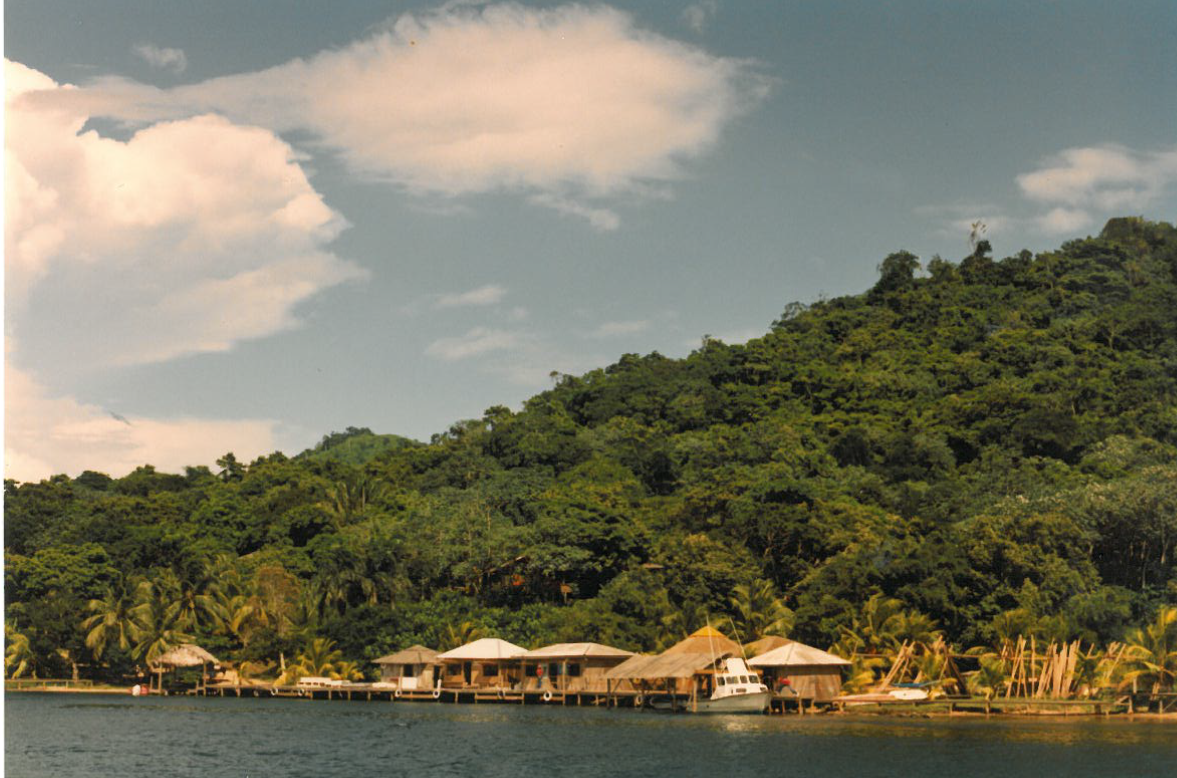 |
Anthony's Key Resort was beautiful.
It would attract divers and non-divers alike. My memory
fails to do it just. Having arrived by riding in
the back end of a pickup truck, we were taken to a small
boat dock where we were ferried from the main resort
facility to a small cabana some 50 yards away on a tiny
island. The huts were about 20 square feet with
two beds, a freshwater shower, and a place to hang your
clothes. Although we were in a warmer climate, the
louvered sides of the hut and ceiling fan kept the room
quite comfortable with the evening breeze. To
return to the main facility, you merely had to walk down
to the landing and bang on a suspended dive tank with an
attached steel pipe and your taxi boat would take you
across for dinner or whatever. |
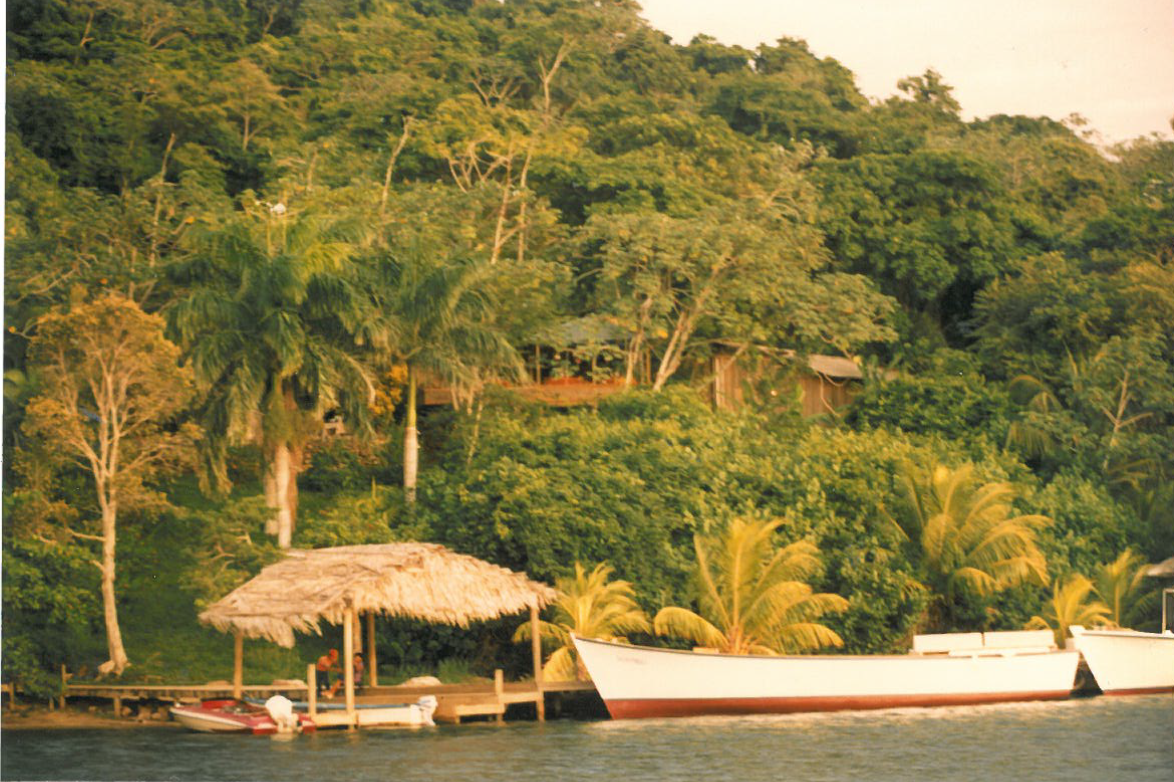
Having checked into the dive shop to pick
up weights for our belts and to show them or dive certification
cards, we were prepared to make our first dive the following
morning. "Peter's Place" (named for Peter Hughes) was our
checkout dive. It was also the maiden voyage of a new dive
boat for the resort - christened the Don Pablo and constructed
there on the island from wood, freshly painted light blue with
white trim. So fresh, the afternoon's sun made the paint
stick to our equipment. We carried traces of that boat on
our equipment an every subsequent dive trip.
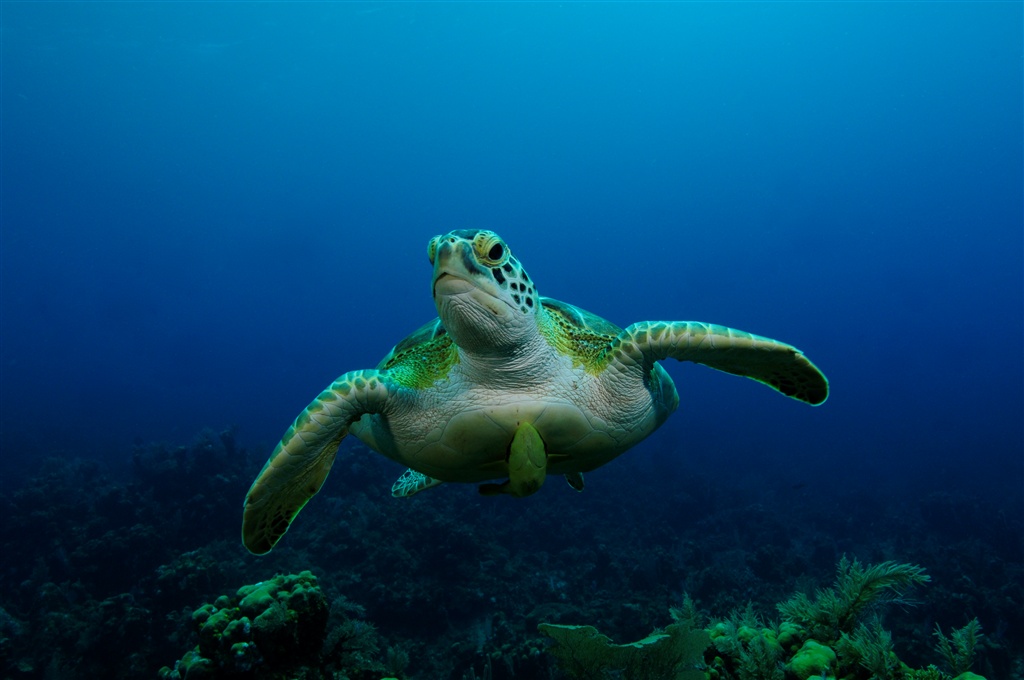 |
The dive itself was lovely.
We encountered a large green sea turtle gracefully
gliding through the water. The water was a
comfortable 85 degrees and visibility was easily 100
feet or better. The diving as a whole was much
slower paced and we didn't venture as far from the boat
or stray from the Dive Master - we had learned our
lesson the hard way. Covering less ground and
probing more, we learned what to look for and where to
search. We were also consuming far less air by
expending less energy and were frequently the last
divers out of the water and into the boat. |
The afternoon dive was at "Pillar Coral" -
aptly named for the coral formations that grew upwards to appear
to support the water's surface. I had just bought a
close-up lens and was anxiously snapping away at every micro
organism and fish that could fit within the frame. I
wasted a lot of air to situate myself for the perfect picture
that never turned out as good as I remembered. A
professional with all of their equipment might get one good shot
for every ten taken, but an amateur like myself couldn't get one
good shot in 100.
| "Crab Hole" is where I first
learned to look for small crustaceans that I would look
for on every subsequent dive - a sort of mascot for me -
the Arrowhead Crab. This
spider-like crab with its pencil-thin legs and body,
tiny claws, and pointed head fits easily onto the palm
of your hand. Ranging in a variety of sizes and
colors and situations, I rarely turned down the
opportunity to carefully pick one up to watch it crawl
around before placing it back where I found it. |
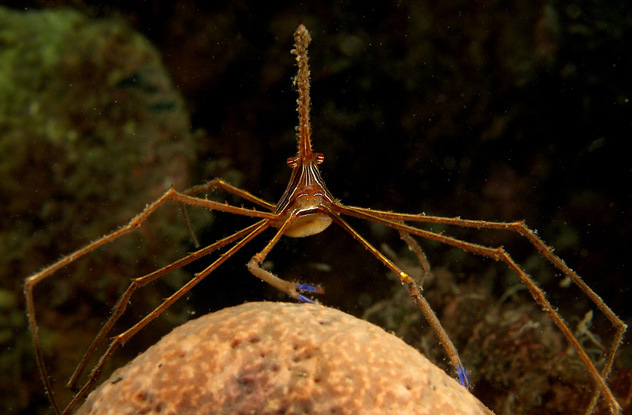 |
The dining at Anthony's was superb and
included a large selection of seafood prepared in very
imaginative ways. Another delicacy we enjoyed were the
banana chips. Sitting at the bar before dinner one
evening, the staff brought out a large platter of chips hot from
the fryer. Thinking they were just potato chips, we were
pleasantly surprised to find they were in fact bananas, sliced
diagonally, and rolled in Parmesan cheese before being deep fat
fried. I could have made a meal on them alone. All
attempts to reproduce them at home have failed miserably - but
they wouldn't taste the same even if I knew the recipe.
Our night dive wasn't anything of note.
The entry from the boat was poor due to rough surface
conditions. My dive light only worked part of the time -
the part when I didn't need it. I eventually lost it
altogether. Literally, I lost the light and ended up
diving close to Dad whose light was working.
The drift dive, on the other hand, was a
wonderful experience. This was our first drift dive.
Drift dives are generally done in an area where the currents
make swimming impractical or impossible. The diver enters
the water and lets the currents do the work - you float along
for the ride. The dive boat follows the trail of surface
bubbles and picks you up when you are done. The
disadvantage is that if the current is too strong, you can't
stop to look at anything for very long without expending a lot
of energy and air. It's a relaxing way to dive and even
more enjoyable when done along a vertical wall.
Picnics were a staple at the resort.
It's a day when the staff can relax and have time off while they
ship the guests off with coolers filled with fixings prepared
the night before or that morning. The picnics were
generally on a beach and the trip consumed the entire day.
A dive was made in the morning, picnic for lunch, snorkel as
your food digests, and then a dive in the afternoon. Our
picnic was on a beach of glistening white sand. Some of
the guests went crab hunting, and one of the boat crew trolled
for mackerel; which he did catch but was eaten by a barracuda as
he brought it in. The afternoon dive was a drift dive
along a wall. We saw numerous angle fish, sand dollars,
and sea biscuits as well as an ENORMOUS rock crab.
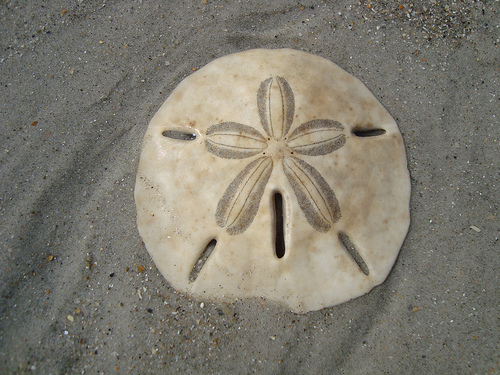 |
Sand dollars and sea biscuits are
burrowing members of the sea urchin family. The
flat species are the dollars, the inflated species are
the biscuits. |
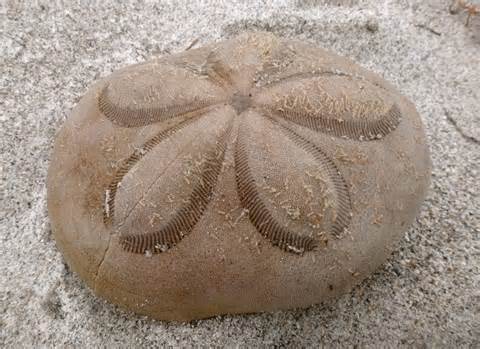 |
August 18th was an uneventful day of
diving and nightlife. We dove "Hole in the Wall" in the
morning; a keyhole tunnel downward into a coral head. Most
of the divers went down the tunnel that came out at 150 feet.
Dad and I chose to stay in the shallows so that we would have
more bottom time - the deeper you go, the greater the pressure,
the less air time you have. Those that went down the
tunnel had a bottom time of five minutes; Dad and I dove for
almost an hour.
The afternoon dive was at S.O.S (Same Old
Story) which wasn't as repetitive as the name implies. We
observed several bristle worms - which are a no-touch - a large
green eel, and the first Portuguese Man of War I had ever seen.
The color of the float was a striking hue of purple with
tentacles that hung for several yards below.
The highlight of the day was what occurred
that evening. Among the guests at the resort was a man and
woman with several other couples who had traveled together to
various islands for several years. The previous day, the
man proposed to the woman and they decided to get married there
at the hotel. The local minister (Methodist or Baptist, I
don't remember) agreed under the condition that she wear a long
dress; formal attire is not necessary or comfortable in the
islands where t-shirts and shorts are the typical fashion.
The man and his soon-to-be-bride made a trip into town to buy a
dress while the hotel staff and their friends made arrangements
for the wedding and reception.
The following evening just before dusk on
the little Cabana island under the arch of palm trees facing a
beautiful orange sunset, the man and woman were married.
The minister's daughters sand a duet in their native tongue.
All the guests were invited and the ceremony was charming. The
minister said, "Now you woman, you obey your man. And if
your mama tell you one thing and your man tell you another, you
obey your man." "And man, you treat your woman right."
The traditional vows were exchanged and the marriage was
complete.
The hotel staff made a lovely layered
wedding cake with - of course - coconut icing. It was as
nice as any professional cake I've seen. The music for the
reception was live and lively. The music equipment was
held together by duct tape and luck. Friends of the couple
made arrangements for a couple cases of champagne to be flown in
for the occasion. I have seen most of my friends married
off; some more than once. I have never seen a wedding that
meant so much to so many. What a marvelous way to start a
life together. I've always wondered if the couple is still
together.
Most of our afternoons were spent sunning
like the local iguanas on the deck of an uninhabited Cabana,
laying on bamboo mats. Preparation for surviving the hot
sun usually began months before our trips soaking up as much
Midwest rays as possible to be as tan as possible when we
arrived. We still used a waterproof sunscreen, but it
helped keep us from looking like boiled lobsters during our
stay.
"Lighthouse Bay" and "Gibson's Bight" were
both shallow water dives where we saw numerous brittle stars,
spiny lobsters, jelly fish, and arrow crabs. We also saw
two extremely large crabs facing off. They were far too
big to approach and did not seem threatened by our presence.
one of our dive party reportedly saw a nurse shark. We
have never seen sharks in the areas we dove. We were more
apt to see skates and rays.
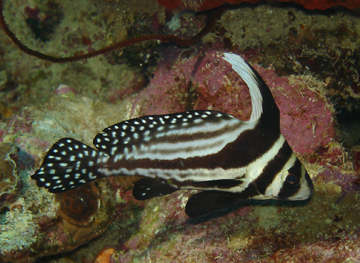 |
The "Gwenda Lynn" was our deepest
dive to date. She was an old wooden banana boat
that got caught in a storm and sunk in 120 feet of water
taking one crewman to a watery grave. The boat
lies on her hull exposing a cargo of batteries and
gears. We anchored over what appeared to be
nothing. The Dive Master said the wreck was just
below us and our bottom time was not to exceed 10
minutes. After gearing up, we dove in, attained a
lightly-less-than-neutral buoyancy, and floated
spread-eagled down to the wreck. The feeling was
exhilarating. Once at the site, I was amazed to
find two large spotted drum fish - a beautiful black and
white fish (left). The juvenile drum (below) has
banner-like fins. Tap-tap-tap on a tank and we
look for the Dive Master who signals it's time to make
our slow ascent.
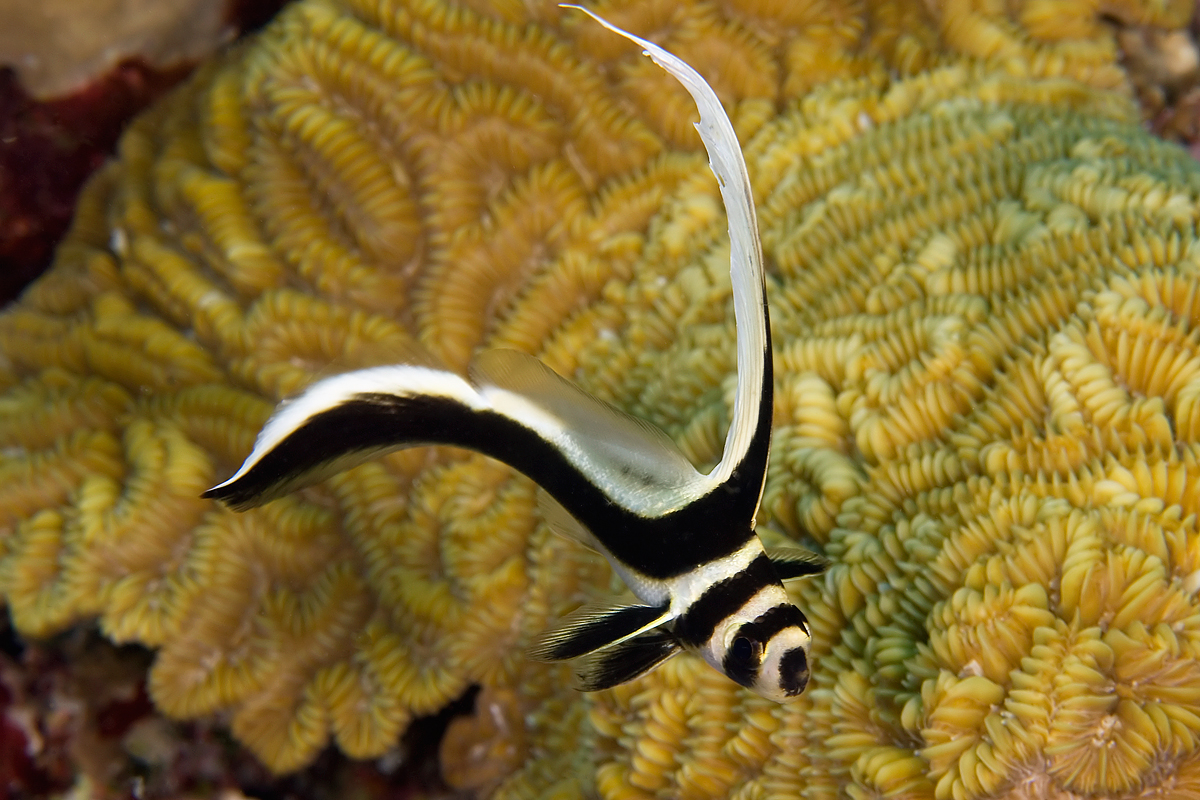 |
I've neglected my narrative in not
mentioning anything about our Dive Masters. Tino - the
head Dive Master - was the most experienced of the divers and
was trained personally by Peter Hughes. A short, stocky,
but well-proportioned man, Tino was an excellent Dive Master.
His assistant was David. Tino had a beautiful wife and
young son who would gallop by the dive shop on his stick horse
wearing a cowboy hat and cap guns. Peter Hughes also dove
with us once while we were there. The man wore more gold
than Mr. T., but he was a consummate diver and a stickler for
perfection.
Our last dive was "West Wall." The
wall dropped off to what seemed infinity. It was a good
dive and an excellent end for a tremendous dive trip.
Back to

Back to

|